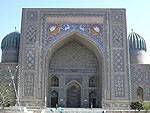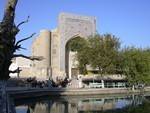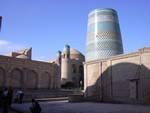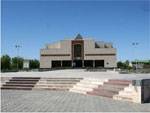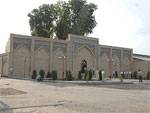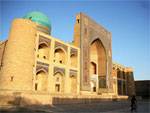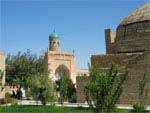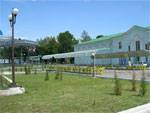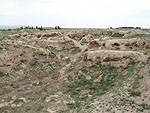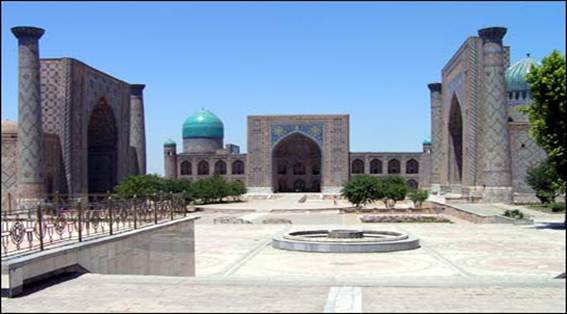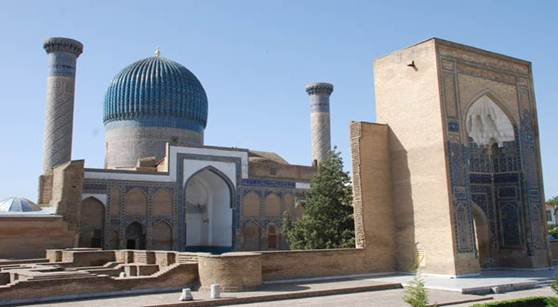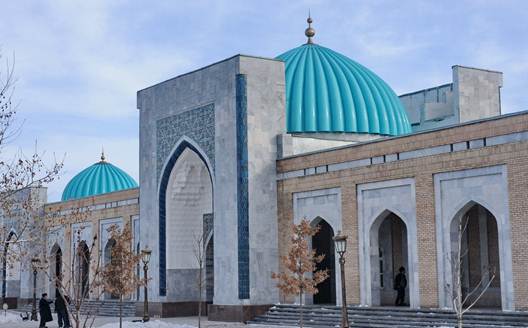Pearl of East: Your travel guide in Uzbekistan.
|
Main Menu
Tashkent
Samarkand
Bukhara
Khiva
Baysun
Nukus
Margilan
Ferghana
Nurata
Namangan
Kokand
Sarmysh Say
Termez
|
News / НовостиUzbekistan: The ancient cities of Uzbekistan the sights of Samarkand10/04/2017 13:50 Registan Square. Administrative and trade, handicraft center, the heart of old Samarkand, a symbol of modern Samarkand. One of the most outstanding samples of urban art in Central Asia. There may be “leafed through pages” of multi-millennial history of Samarkand. The entire history of the ancient city is reflected here. Registan today is adorned on three sides with majestic buildings: Ulugbek's Madrassah (1417-1420), Sher-Dor Madrassah (1619-1636), and Tillya-Kari Madrassah (1647-1660).
Mausoleum Gur-Emir (XIV-XV). In 1404 on the orders of Amir Temur were erected mausoleum of Gur-Emir – ashes to his favourite grandson Muhammad Sultan. Grandeur and lightness of architectural lines and shapes, richness of colourful mosaic-all this makes the mausoleum a unique monument of Central Asian architecture. In the Mausoleum Gur-Emir buried, excepts Timur, his two sons - Shakhrukh and Miranshah, his grandchildren Mohammed Sultan and great astronomer Ulugbek, as well as Timur's spiritual mentor Muslim Sheikh – Mir Seid Bereke. Shahi-Zinda necropolis (XI-XV). It consists of 11 mausoleums; consistently throw out one by one over 450 years, from XI to XV centuries. Name “Shahi-Zinda” (live the king) is connected with the imaginary grave of Kusam ibn Abbas, who arrived in Samarkand in the VII century together with the invaders – Arabs, and preached Islam. Kusam ibn Abbas has suffered for the faith, was attacked by “infidels” when prayer. The Mausoleum built in the middle of XI century, over his pretended grave, had served as the core of the ensemble - Shahi-Zinda necropolis. The architectural ensemble Shahi-Zinda is a unique museum of glazed decor. Mosque BibiKhanum (XIV-XV). The mosque was erected on the orders of Amir Temur during 1399 - 1404 biennium. The mosque was the largest in the East in the XV century. Around the vast courtyard (78x64 m) were placed grand buildings, interconnected by domical gallery of 480 columns. Today the mosque came in ruins. Works on the restoration of the mosque were finished in 2004. Ulugbek Observatory (1429). It was built on a hill Kuhak, at the foot of Chupon-Ata Heights. It was a three-storey round building of 46 m diameter and of 30 m height, covered with colored tiles. In the main hall was placed sextant “Fakhri” - a great instrument for observing the Sun, Moon and other celestial luminaries set. The size of the main instrument, its successful design, scientific knowledge of Ulugbek and his colleagues provided amazing accuracy of astronomical observations. The observatory was a unique structure for its time. Complex of Imam al-Bukhori (1998). Imam al-Buhoro in the IX century, was born in Bukhara, but died and was buried at neighbourhood of Samarkand in 810. He devoted his life to collecting of Hadith. Imam accumulated and put in good order 7275 Hadith, and many of them were included into “Shariat”. Over his grave tomb in the 16-th century was erected a mausoleum, and nearby was built the mosque and planted platan trees. In 1998, in connection with the celebration of 1225 anniversary of the birth of Imam al-Buhori in place of the ancient mausoleum was erected a memorial complex. A visit to this holy place of Muslims is equal to the small Hajj.
|
Calendar
Weather
Useful Links
Searching for Airways and Hotels
|

